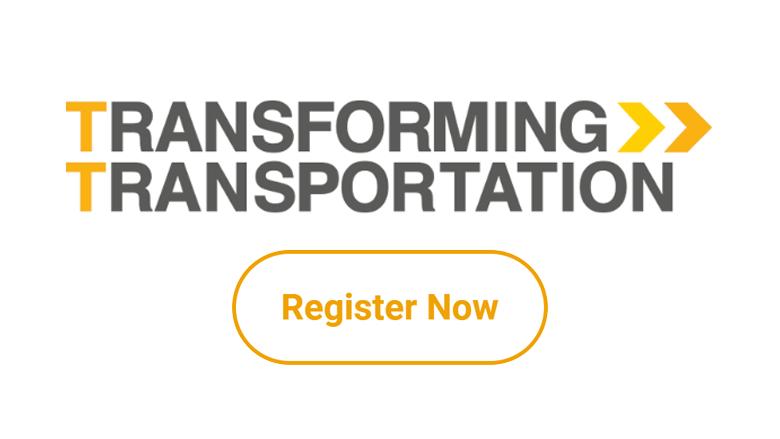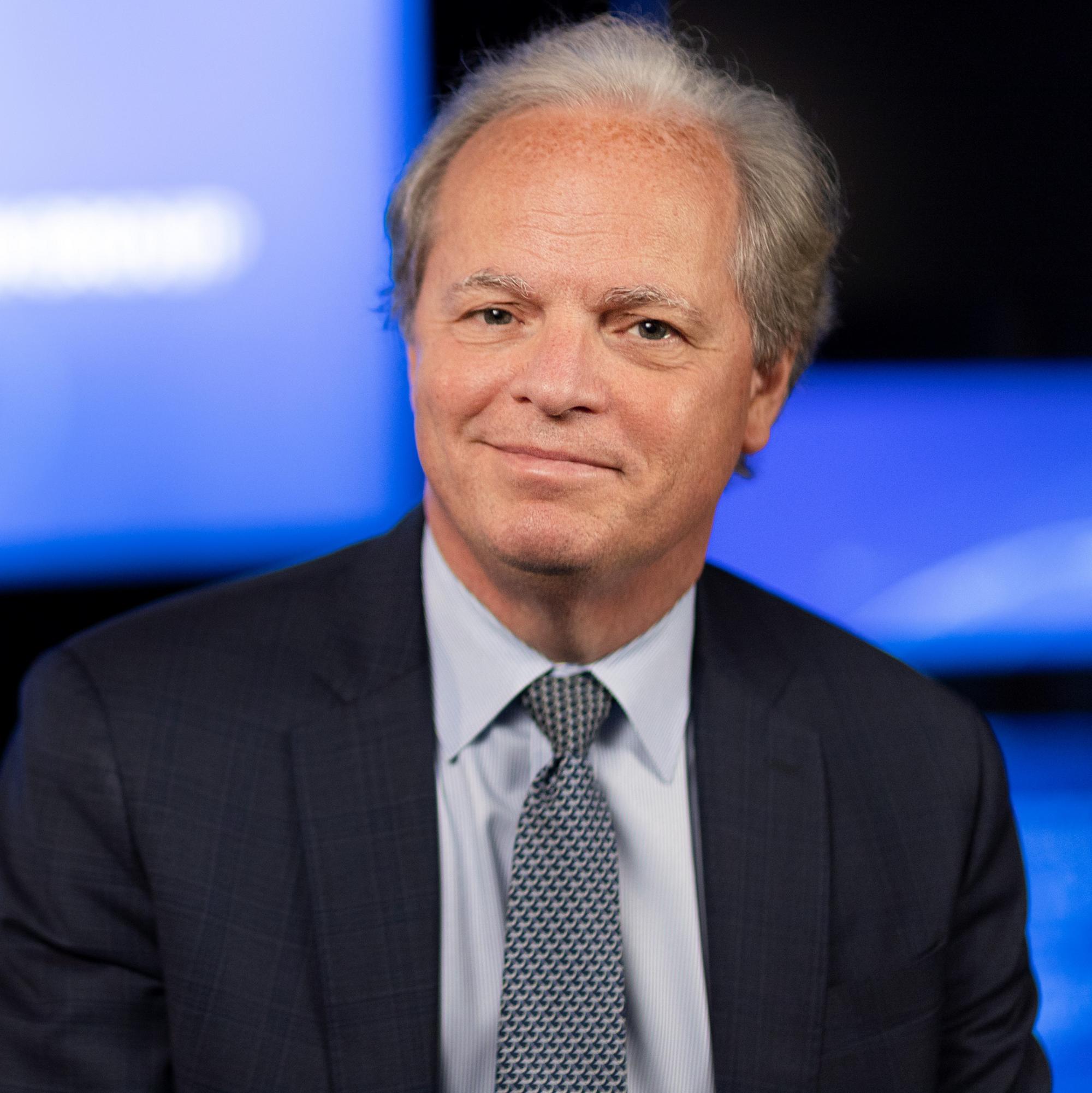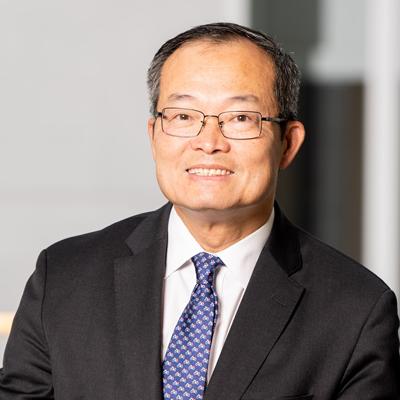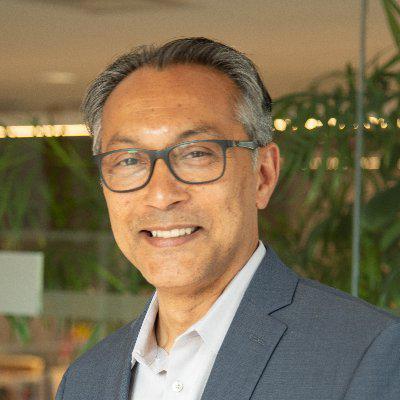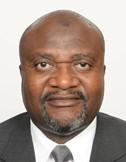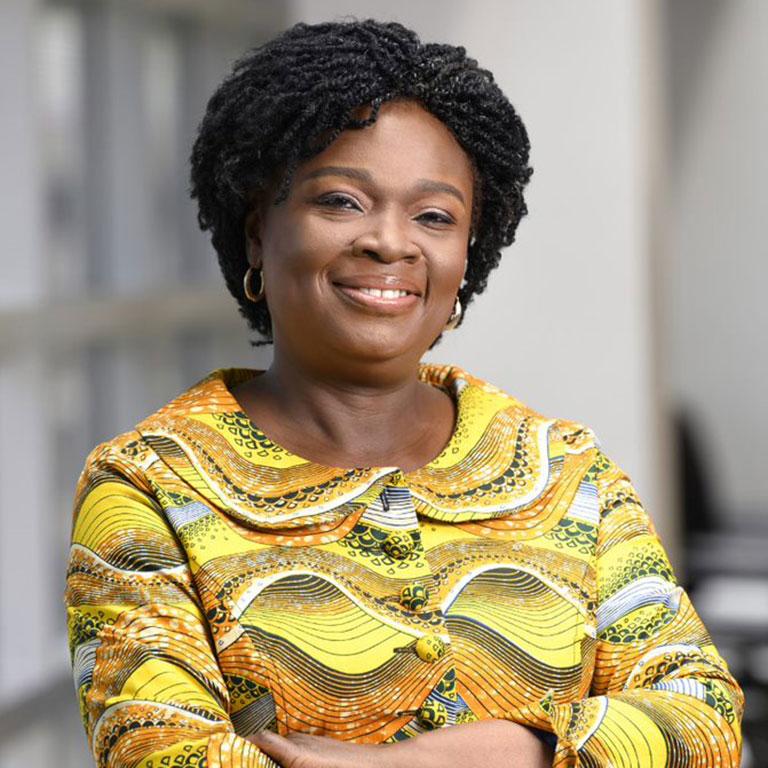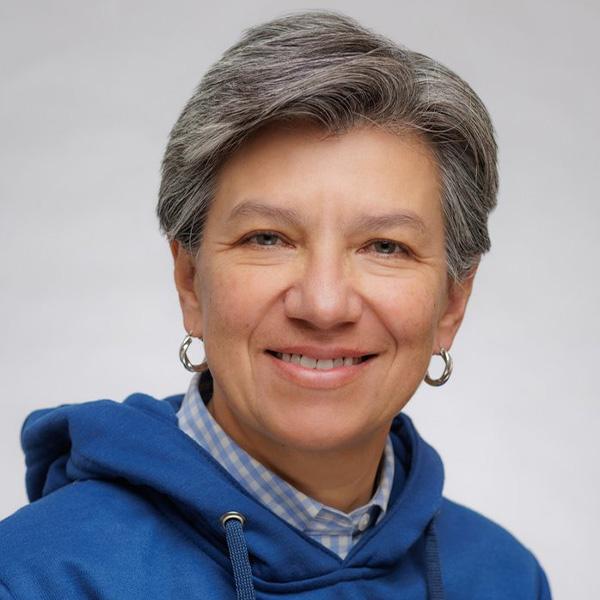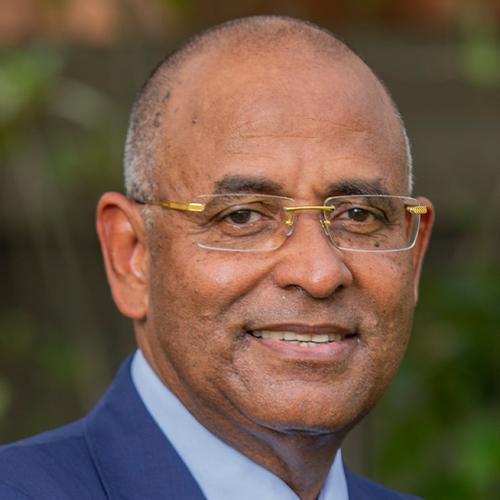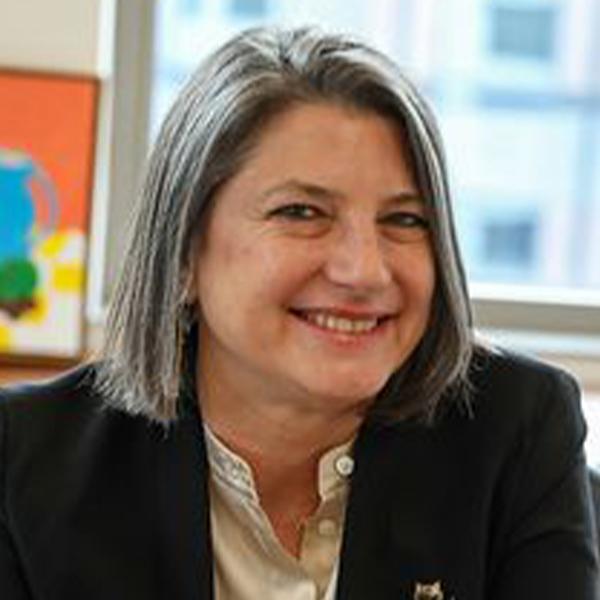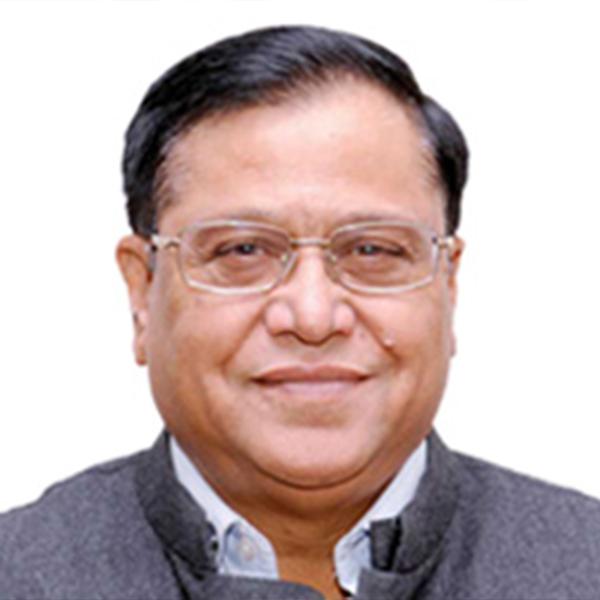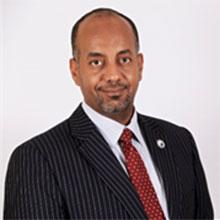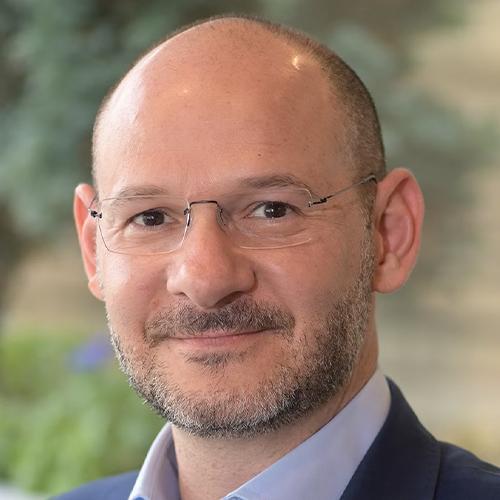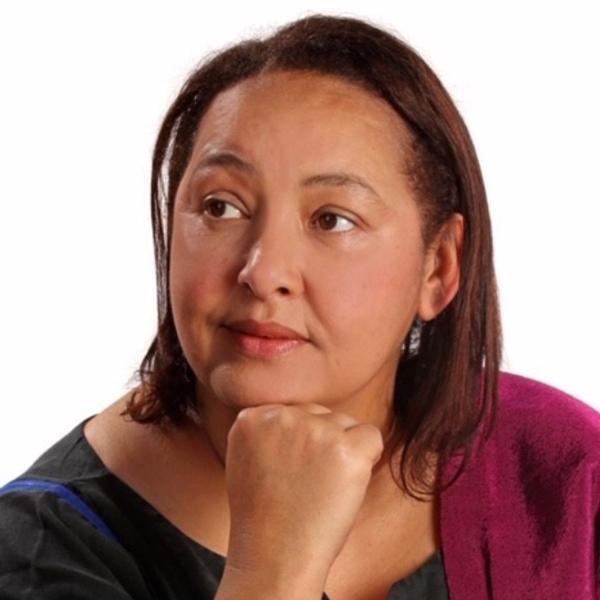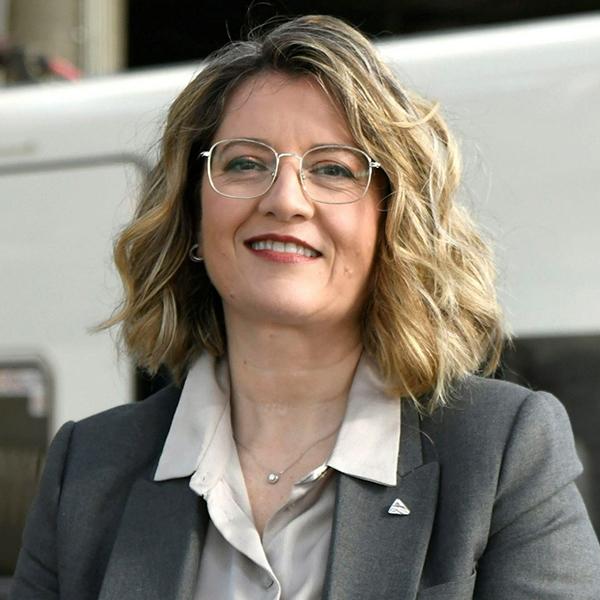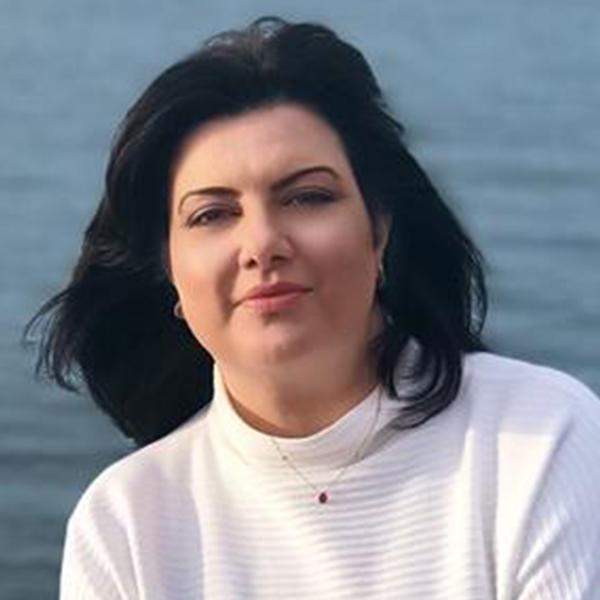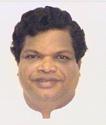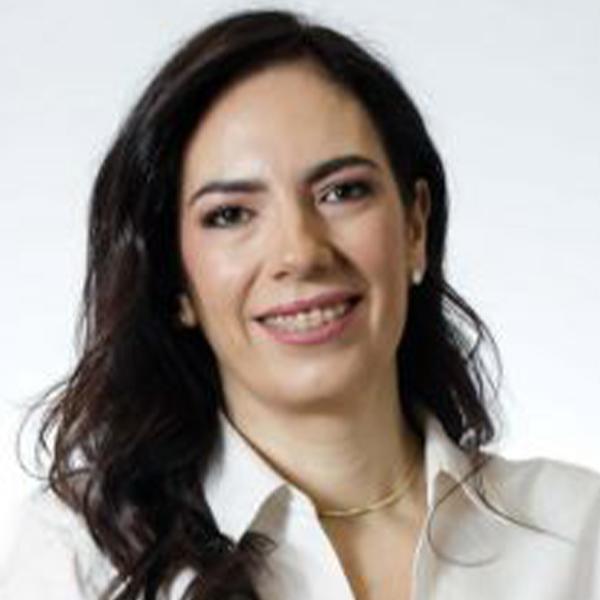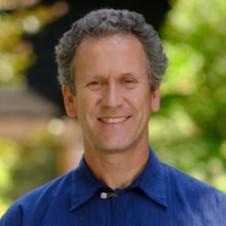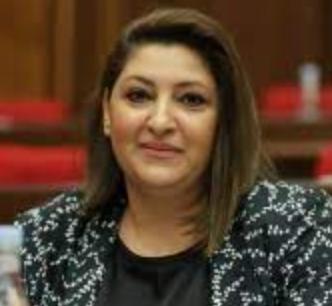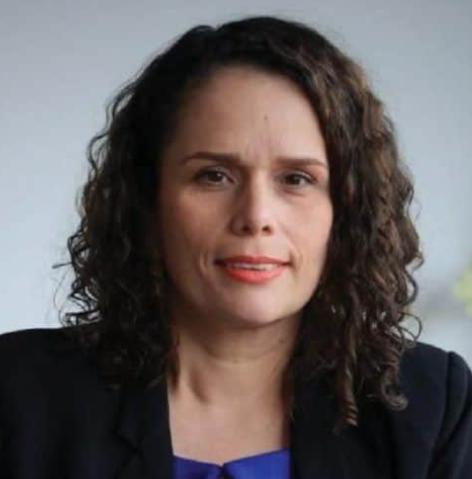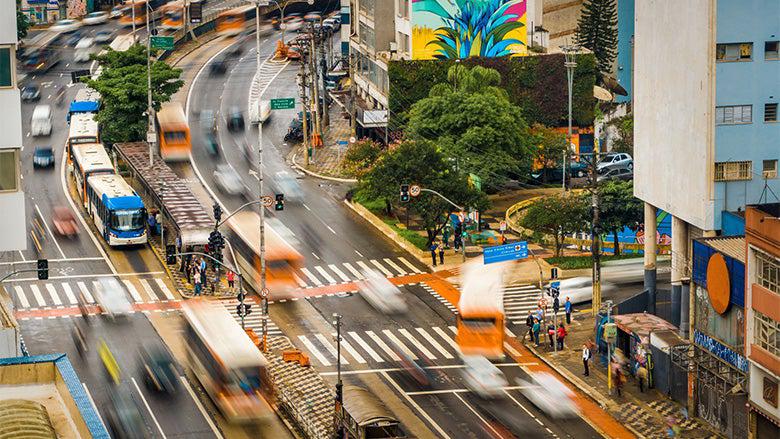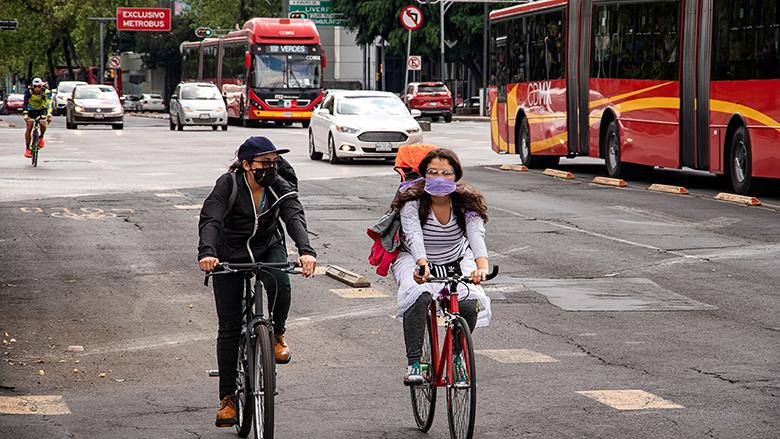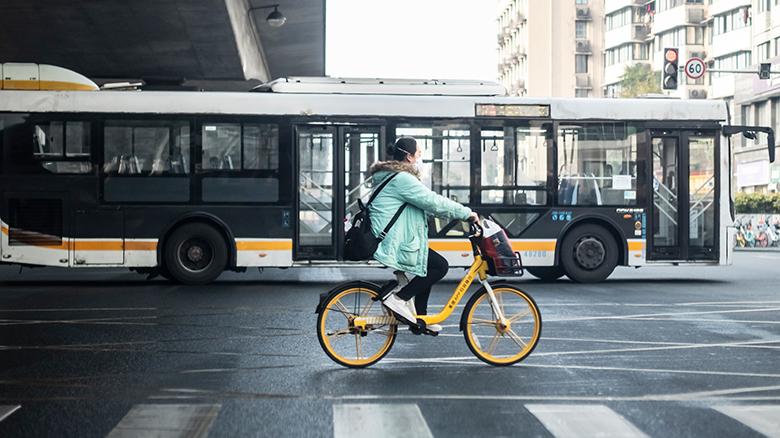[Femi Oke] Hello, transport professionals and leaders. Leaders of transport professionals. This Is Transforming Transportation, the 21st edition and the second one that is fully hybrid. So, if you're online, I know you've already done this, say hello to your fellow online attendees and your moderator, who'll be making sure that you are part of the discussions and the conversation. If you're in the room in the Preston Auditorium, you literally say hello to the nearest people to you. I will wait. [Laughs] [Femi Oke] That didn't take long. Very efficient. I appreciate that. Our conversations today will be had in this room using that microphone right there in the center of the room, towards the front, but in the aisle. Get used to it. Do not feel shy about standing behind that microphone when you have something to say, because that is how I know that you are also part of the conversation. #TTDC24 for our global audience who are joining us online is the way that you too can be part of the conversation. Our opening segments on day one and day two will be on World Bank Live. So, we could not be here without two very special sponsors. Our lead sponsor is FedEx. Break into organic applause. [Applause] Our development partner, the FIA foundation. More organic applause. [Applause] You may notice there is not a program insight, almost no paper in here, because we are sustainable, but wherever you see that QR scan, that's close to any of our Transforming Transportation branding that will take you to our online agenda. If you've already got the app on your phone, congratulations, you're a pioneer. And you will know then, who will be doing the opening address. Transforming Transportation is brought to you by the World Bank and the World Resources Institute. So your opening remarks will be delivered by Guangzhe Chen, Vice President of Infrastructure for the World Bank, and also Ani Dasgupta, President and Chief Executive Officer of the World Resources Institute. In that order. Welcome, gentlemen, to do the welcomes. Thank you.
[Guangzhe Chen] Thank you, Femi, and good morning. Welcome to Transforming Transportation 2024, the 21st edition of this forum. Ani and I were just chatting. When we started some 21 years ago, we didn't expect this will last 21 years, but it was a fairly moderate transport symposium at that time and is really becoming an international forum by the participation and also the high level of attention. You might also notice that during the COVID in the past, this forum was connected in January with TRB because we thought, at that time, bringing people to come to Washington delinking with TRB, we may not get the attendance. Well, since COVID actually gave us a reason to actually think about planning this separate from TRB, but it turned out that we still have a really good attendance and also great participation. So, thank you to all of you for joining. We find ourselves in a pivotal moment where the decision we make today will have a lasting impact on environment and for generations to come. The urgency to reduce greenhouse gas emission, especially within the transport sector, call for a broad innovation, transformative policies and on voting actions. In this context is paramount that we also underscore the urgent need for financing sustainable solutions. We all know, working in this sector, the tremendous gap obstacle in the sector, particularly in the developing world. As of today, we still have 1 billion people that live more than 2 km away from all the way the road and one in six women globally do not look for jobs out of fear of harassments in public transportation systems. World crashes still claim 1.35 million people in the world and 90% of that is in developing countries. Now, solving these challenges is possible, but it will require unprecedented investments and financings. While I'm talking about financing here, because that's the theme of TT 2024, of course I'm not saying that this is the only solution. We always say financing has to be supported with some policy, regulation, knowledge, partnership and all those. But that being said, the theme of the TT 2024 is about mobilizing finance for climate actions. Country by countries and city by cities, the World Bank's approximately $40 billion of transport portfolio investments throughout the world is contributing to these engagements and really for aiming for in a new mission for the more livable planet. Just a couple of milestones in 2023, the year we just completed, we have a number of achievements through the World Bank engagements. In Quito, Ecuador, a new, brand-new metro is providing a clean, efficient mobility for over 400 passengers a day, and we are proud to be a partner in that engagement. In Dhaka, Senegal, we're also launching Africa's first ever all electric bus rapid transit system, for which the World Bank Group, I want to emphasize, was engaged in these ventures. In the South Pacific. We also work with six small island countries for major road upgrading port and airport infrastructure in those small islands, and then in the global facility for decarbonizing transport we're also very happy to welcome Spain as our new partner and energize this work to reduce transport emission in low- and middle-income countries. Despite all these efforts, the financing need for sustainable transport is beyond what government and MDBs altogether can provide. We must mobilize capital at a greater scale, and that's at the core of the World Bank's evolution roadmap. Private sector investments are necessary to truly meet the outsized need, but also to bring solutions, innovations to the challenge we face. The World Bank's evolution roadmap has been under discussion and the various initiatives has really calling for one of the focus is on mobilizing private financings, especially in a way to leverage using our financing to provide a catalytic role to leverage more commercial and private financing in all development space. To illustrate how this works in practice, consider the new bus rapid transit system in Dhaka, Senegal. As I said, this is the first all-electric bus system in the African continent, but I think what's most interesting and for us most important way of looking at this engagement is how we can all work together. This program brings together various partners from within the World Bank, from the World Bank but also IFC and MIGA. But we also partnered with other different partners like European Investment Bank and of course the government, Senegal and private sectors. The World Banks, so IDA provided financing for the infrastructure and then IFC provide advisory service to advise the government on the PPP structure of this infrastructure development. And MIGA also provided a guarantee that mobilized Meridiam, which is a big asset management company, to provide financing for the fleet. So, the impact of this project demonstrates what is possible from a World Bank Group approach. But, of course, we want to recognize that this is just the beginning of the project and the work is still ahead of us. The World Bank is working hard to enable investment like this and just a few weeks ago, President Ajay Banga announced that a unified guarantee platform of the World Bank, combining all the guaranteed instruments from the Bank, IFC and MIGA and providing a one stop shop to really to facilitate this kind of investment moving forward. Another example I was also mentioned is the Quito Metro, which began operating this year. I mentioned already, that's groundbreaking for several reasons, including scale, climate benefit and socioeconomic benefits. This is an investment that includes several MDBs ourselves, but also Interamerican Development Banks. And this is a program that required over 2 billion dollars. So how to mobilize financing is a key factor in this engagement. One of the key partners that we help make Quito Metro a reality is, I mentioned, IDB and I want to personally thank Ms. Ana María Ibáñez, Vice President for Sectors and Knowledge, IDB, who is here with us today, and also the mayor Pabel Muñoz confirmed it. I think he will be connected online, and we are looking forward to continue to partner with you. With all of us here, we can certainly find more ways to help to step up this kind of example that I just mentioned, and I hope the following days, two days will be a really engaging discussion and really fruitful partnership that we can join together. And I'm personally also looking forward to hearing from Crystal Asige, a singer, a songwriter, a champion for disability, right, and for her trailblazing effort in the Kenyan government and senate. And then we'll hear more from her. We have two sessions dedicated to learning from the experience from a diverse set of transport ministers. And again, I think that will be the next session. Finally, as I mentioned earlier, Transforming Transportation would not be what it is today without a great partnership with the WRI and Ross Center. And I'm really happy to see Ani, my partner in this engagement here today. So, let me stop here and pass on to Ani and thank you very much for your participation. [Applause]
[Ani Dasgupta] Wow. Good morning. That's my only task is to welcome you all on behalf of WRI, to TT 24, and to everyone, I think Femi said, everyone who's connected online, warm welcome to this year's Transforming Transportation. As Femi said and Guang said, this is our third decade of doing this together with the World Bank and I just want to say this is only third because only, because of all of you have participated and contributed to make this the premier forum for discussing intersectional transportation, development and climate. So, thank you for being with us. And the funny thing is, actually there are people in the room who were there in the first TT. So, thank you for being with us all this time. I just want to say, it's an absolute pleasure for me to host this jointly and have this event with Guang. And I see José Luis [Irigoyen] here, who was a partner in crime before that. So, you know, sometimes feels like I've never left, but it is great to be back here. And I'm very excited actually, this year that our focus is on finance. I personally strongly believe this will be one of our bigger barriers to cross and that we are doing this with the World Bank and World Bank Group, as Guang correctly pointed out. And this is a great opportunity. I want to share with you that I think last year was a very important year, positively, for our business of transportation. And I think we have a big task in front of us for the next two days. I spent two weeks in Dubai in December for COP. A lot of you I see in this room were there. And I just want to point out that the COP this year happened in the middle of a pretty tricky global environment. It happened in UAE, a big oil producing country. People were already skeptical. “Will they do anything useful?” It was run by the head of ADNOC, their oil company. Again, people were more skeptical. “Would anything good happen there?” It was happening at a time there are two wars going on in the world that seemed no end. We don't see any end. The overall confidence of the world in multilateral processes were at a low. In spite of all these, the outcome of COP actually was more positive than any one of us expected. Anyone with a lot of skeptical people, some of you are right here. All, even the most skeptical people, that actually the COP outcome was more positive than we expected. It wasn't perfect, but it was more positive. The most positive thing, the many positive thing is the 196 countries for the first time actually said “we need to get away systematically from fossil fuel” for the first time. It might seem obvious to all of you, but it's the first time the language was used in that. And it matters actually, and it matters because transport is 23% of that fossil fuel. So, all of us, our responsibility now is to help countries to figure out how do we use the transport mechanism to actually make that commitment to a reality. Two other things happened that are actually very interesting. The world also committed to triple renewable, but double efficiency. Transportation actually has a huge role to play to get to the doubling efficiency goal. And the third thing that happened is that the world, for the first time committed that the cities, or decarbonizing cities is a critical part of decarbonizing the world, that it'll be part of NDCs, for the first time, 130 plus countries actually signed the declaration, but it became part of the ultimate agreement called “UAE Consensus”. I'm just saying this because that these things, we as a community been complaining for a long time that the global processes don't recognize transportation. Correctly so, I think we were complaining correctly, but now there are things in place that actually gives us an opportunity to push this forward. And the last thing I'm going to say is just before COP, United Nations published a report called the “Global Stocktake”, which was the first time there was evaluation after Paris. How are we doing? How is the world doing? Obviously, it said we're not doing very well, but it said two other very important things, that we need to take a systems approach towards outcome. We won't be able to solve this by sector by sector, and talked about how transportation needs to be a systematic approach, not only of decarbonizing, but actually to getting modal shifts, getting public transport, walking, biking and electrification at the same time. These are all things we've been saying for a while, but now 196 countries seem to embrace it. But not only global things are happening. Actually, things on the ground across the world are taking place that are very innovative. You heard from Guang, terrific example just now. I was in India just a week back, two weeks. We have a team there and a lot of, actually, the World Bank colleagues here. I just met with Olivia who works very closely together, India last year, collectively, four cities collectively procure 5000 electric busses that when one procurement reduced the operating cost of electric busses by 60%. This year they're committing to buying 800,000 electric busses. 800,000 busses, not electric, would be a miracle in India. They're 300,000 busses short overall. So this leap frogging of not only providing public transport but electrifying at the same time is the kind of momentum, kind of change we need. So we need to see how this happens everywhere. So this is just one example. These kind of things are happening. So the question is over three decades now, 21st year, one thing we have done here most importantly is build a community of practitioners. All of you, a lot of you know each other, I hope all of you get to know each other by the end of the two days. We actually have a huge opportunity and a task in front of us. And I just want to outline for you my view of what this TT, what success of this TT might look like. The first success would be all of us helping countries actually meet the commitments. They met in Dubai, in Belém, not this year. The next year all the countries will come with a new commitment, new NDCs is called to see how the transportation NDC, which has been really difficult to get to, actually part of the solution, part of the system change the world needs, part of the commitments they've made. Only 92 countries today, actually of 196, actually have anything to do with transport in their commitment. And very few actually, even the 92 are very detailed. So, this is our task to, there are a lot of ministers here in these two days, actually build partnerships with them to see how we can actually get to the outcome they have committed to in a technical, feasible manner. The second is finance. There's only 1.3 trillion dollars in climate finance today if you add up everything, which people estimate and you hear from speakers in the next two days is about five times smaller than it needs to be. It needs to be about nine to 10 trillion dollars by the end of this decade. So the question is how do we get to that finance? How do we get to private capital flowing here? And this is where World Bank Group’s leadership is very important and how do we actually make the system? We need to have many different innovation finance to get blended finance, get innovation in it. You will hear from Frannie Leautier, who's doing phenomenal work in Africa. You'll hear from Vera Songwe, who like me, also used to work in the Bank, about how we can get to a financial outcome that is good for, not the planet, good for people, but good for countries. So, finances would be a critical thing. I'm very happy that we are focusing on that. The third thing, we need to do better, I think that we are very good at doing as a community is learn faster from each other, innovation taking place across the world, that we need to be faster at bringing one innovation from one place to another. And you will hear from Claudia Lopez, I think just in a few minutes. In Bogota, that's 600, I think 630 km. Cycling, 6%, 7%, 8% of population actually cycle to work in a phenomenal change that has happened in Bogota. The question is not only what she did, you will hear, but how did she do it and how can we replicate that in other places? So it's an exciting moment. We have work to do. I hope we have a really successful two days here. I want to thank all of you joining us. I really want to thank all of you that joined online. This has been phenomenal. I think 4000 people have registered for this conference. And as you know, in this room, we can only have about less than 1000 people. So this is innovation. I want to thank the Bank and its technology for making it work. So, thank you for being here. Looking forward to phenomenal two days.
[Femi Oke] So much pressure to be the first conversation of a global gathering for Transforming Transportation. I know just the two people to take on that pressure. Patrick Achi is the former Prime Minister of Cote d'Ivoire. Patrick, please come and take a seat here on the stage. He is now at the Center For International Development, a Senior Fellow at Harvard University, and he will be joining me in that seat just there. Thank you, Patrick. Very good. Either one. Former Prime Minister's choice. Thank you. Claudia Lopez is the former mayor of Bogota. Claudia, welcome. She's now an Advanced Leadership Initiative Fellow, excuse me, at Harvard University. So it is clear that when former leaders die, they go to Harvard University. Heaven, I'm not sure, but great to have you. I would love to know from your position of leadership, we're looking at country perspective, also a city perspective. So, it's nice to hear those two perspectives, but before we start, what story would you tell us to tell us your commitment to transforming transportation? Claudia, one story.
[Claudia Lopez] Well, thank you so much for having us here. It's a great pleasure to be with all this community thinking about Transforming Transportation. So I'm the daughter of a teacher. I'm the oldest of a six siblings family. I grew up in a low middle income neighborhood. And sort of density, proximity and diversity, that's what cities are, that's what they provide. Opportunities for education, for work, for innovation. And the world is divided between cities already made and cities to be built. That's how we are divided. It's not by nations, it's actually by cities that are already made and need improvement, or cities that are still to be made and can be improved. Bogota is the capital of Colombia. It's a large city. It's an 8 million people city in an 11 million metropolitan region. Roughly 40% of the city was self-built by the families. Only half of the city was properly planned previous being inhabited. And I think that's the biggest lesson that Latin America can offer to other regions, such as Africa. Do land use planning in advance, decide location. Thus, we can build progressively, both the private housing, and the public infrastructure, because the money is not going to be there for previously all the money needed. So, the problem is not building progressively. 40% of Bogota was built progressively by families, and the other half of the city was progressively built by the government, both the local and the national government. But land use planning, land acquisition before it is built. The value we created, that's the second message. The value we created by living together, that's the main source of finance to do proper cities. we need to capture that land value increase that we all create by deciding to live together. That's a public, not a private value, and it should be captured either by taxers or by contributions or developers. The third message I will say in my experience, both as a citizen and as mayor, is we have a common, I don't want to use the word enemy, but a common problem to fight against, which is land speculation. Speculators are the ones who take advantage of the fact that we want to live together, that we create value together, and that people need opportunities for income, for jobs mainly, and that's the reason why they come to the city. So, when you do land value planning before, in advance, even if you're going to do that progressively, let's say people are going to come and probably this land is going to be formed, but you are able, as city government, to say, “This is the place in which we're going to build progressively, this neighborhood. This is how we're going to distribute land in advance.” That's the most important, probably contribution that you can make both for the present and the future of the prosperous families in a city. And finally, I will say, in terms of transportation, think about this. At least, I'm sure 25% of your citizens in any city around the world walk. It's a quarter of the daily trips. At least a quarter. We all walk. Nature, walking and biking don't need to be decarbonized. It is already decarbonized, right? It can account easily for a third of the trips. Provides good infrastructure for active mobility. That's the easiest, the cheapest and the most effective thing. The proper forestry, the proper greening of cities, that's the air conditioning of cities, trees, forestry, diverse forestry, properly planned around cities, that's the air conditioning. So, bring together forestry, space for pedestrians, sidewalks and cycling lanes. It costs a penny. With the cost of 1 metro, with the cost of 1 BTRs, you can build thousand kilometers of green pedestrian cycling spaces in your cities. And that's going to change. And finally, we all know for sure that people will use whatever quality infrastructure we built. If you build avenues for fossil fuel cars, people will use avenues for fossil fuel cars. If you build green corridors for pedestrian cycling and decarbonized public transportation, they will use that. Each mode of transportation generates its own demand. So don't waste resources in gray fossil fuel avenues. Invest in green corridors. [Applause]
[Femi Oke] Patrick, I anticipated this conversation because you are a former Prime Minister of Cote d'Ivoire, which means you can go deep, tell us all your dark secrets and feel very comfortable, we will only share it with about 2000 people, but it does give you a sense of release to be able to really talk about successes, challenges, lessons learned for implementing sustainable mobility, sustainable transport. What do you want to dish?
[Patrick Achi] I think at Harvard we say Chatham House rules, except here we are online, I guess. Yeah, it doesn't work here. Thank you very much, first of all for inviting me today and I'm really happy to be at this stage and be able to share with the audience, prestigious audience there, the 20 past years’ experience that I had not only as infrastructure minister, but also as Prime Minister, as you just mentioned. As you first of all talked about country level, my first thought will go to something that the founding father of Cote d'Ivoire said 60 years ago. Road precedes development. Road precedes development. And you could see that in a very remote rural area. If you go there and you ask people between electricity, water supply, road, agriculture, seeds, what do you want? You'll be very surprised. People will tell you road. I happen to be Minister of Economic Infrastructure, started in 2000 and I was hold in charge as infrastructure about water infrastructure. So I'll go to very located remote place in very small villages. And I'll meet women because very often they are the one who are fetching the water, who are making long distance fetching the water. If they don't have clean water, it's really a nightmare for the house. And I'll ask them, out of all the basic needs that you might have in this village, what will be your priority? And she'll say, road. I was really surprised. I said, how come road? You can't even access clean water and you want road? Just meaning that for people being able to go out from the place, they are; either to sell crops, because they have grown crops. If they cannot sell it, they cannot generate revenue either to go or visit people or move is very important to people. So he's invested a lot of resources in infrastructure development, not only road, but also port, airport, to develop the country. And the country has witnessed very fast and important growth for the first 20 years of independence. And then as we move forward, the issue came about how to finance this road. And the World Bank was very active at that time, 30 years back, on the road financing. And they would tell you, I want the traffic before I finance the road. And you say, if you finance the road, I'm going to have the traffic. It was the chicken and the egg issues. So really, road development in the African continent started to really stop as mobilizing resources to be able to finance this road became a real issue because fiscal constraint, limited budget, difficult access to international resources, or private resources to finance road is, I’m pretty sure even today, the biggest nightmare of any government, for political reason, for economic reason, for any reason, as soon as you're elected or within your campaign, the must-ask things by the people is road to be able to access the capital city, the port, the airport or any area, because they feel that's the way they can improve their livelihood. Now it comes to the city, as you mentioned it, 50% of the population, mainly in my country, but also in many countries in Africa, are now living in the city. I guess it's about 80%. We're still lagging a little bit behind, but I guess we're coming there really fast because by 2035, 65% of the population will be living in an urban city. So, developing transport within the urban area is becoming a real nightmare for us because, as you just said, land planification, the cities are growing at such a speed that the country and the government cannot develop the basic infrastructure as fast as people are moving in. So you see a slum being developed here and there and coming after and trying to implement a land development project, a road development project is very, very difficult. We're moving forward and trying to see strategy wise, multimodality actually in Abidjan, having 20% of the population living there, around 5 to 6 million people, we're working on road network, naturally. We have 1.500 busses commuting 1 million people per day. We're working on the metro project, 37 km line. We're working with the World Bank at the BRT project too. We're working on shipyard because we have a Laguna to transport people to the lagoon. And we're working also some private people project on a cable car project. So, all these should give the opportunity of people to lower down the cost of transportation, because at the end of the day, for the people in the city, they do not want to use up all their budget for transport. Today, we are around 30% sometime of the budget going into transport. So how you will do to make transport cost as low as possible with not being in a position like we're doing right now for the city busses to subsidize the ticket? That's a major issue and that brings up once again the issue of financing, because resources are needed for health, for education, for agriculture, for food, for shelter, and yet you need resources to build road and transportation. It puts so much pressure that you're looking for very low, let's say, concessional rate money to be able to finance this infrastructure. In most of the developing world at a community level, you're very lucky, because it's arranged another way, central government is mainly financing the infrastructure of the cities, because the cities are not able to raise enough resources from the infrastructure to be able to finance itself, to raise money by itself. So, the central government is financing the road. So, you develop your road infrastructure or your transport infrastructure, depending on how much resources the central government can allow. And sometimes that doesn't match with your need. So, you have to find a very original way to make transportation as easy as possible for people, and that it comes to management. You have multimodal ability.
[Femi Oke] I like the phrase “find a very original way”. What does that really mean?
[Patrick Achi] That really means that at the end of the day, you have quite an amount of sectors or transporters. You have community busses, you have city busses, you might have metro, you might have, like I say, cable car, you might have all these things. How do you coordinate? You manage people moving from one point to the other point, talking to each of these stakeholders to make it the shortest possible journey and the cheapest one. It's extremely difficult to manage different transport infrastructure and equipment, and at the same time being able also to manage public and private. Some of them are managed by the private sector, other one are managed by the public sector. How do you coordinate all that? Where will be the bus station, the shipyard Laguna station, the metro station? How will they go from the house to the station? All that has to be managed in a way that things are made easier, simpler and cost effective for people.
[Femi Oke] Claudia, you have a thought. Patrick inspired a thought. Share it with Patrick.
[Claudia Lopez] So you made a very crucial question. What is actually the innovation here? What are we talking about? What is innovation at the moment? So, let me give you these figures. 65% of public transportation trips are made by women. 65% of fossil fuel car trips are made by men. Girls and women and elders do more than half of the walking trips in every city. Women in almost every city, particularly in more than half of the planet population in the Global South walk more, work longer, and are paid less. And that's the biggest source of inequity in our cities and in our planet. So, do you want a simple planning trip to do or advice to follow? Plan your cities thinking as a girl, and build your cities moving as a woman. [Applause]
[Femi Oke] Claudia, that will be the simplest and probably most advancing thing to. Why?
[Patrick Achi] I though you would have said thinking like a woman, moving like a man?
[Claudia Lopez] No, that's exactly the wrong thing. If we move like a man, then we move mainly by fossil fuel, private cars. That's unsustainable. That's unfinanceable, that's undesirable. [Applause]
[Femi Oke] The women are clapping. The men are not clapping. [Laughing]
[Claudia Lopez] So you are all promoting change. Men of this world, welcome to change. Because if we move the way you move… [Applause]
[Femi Oke] If you would like to have a debate with Claudia and Patrick, now is your moment. The microphone is right there. Stand behind it, because I'm going to only give you about five or six minutes. You actually want to have this conversation right now. Online? O’Neall is the moderator. Right. O’Neall, do you have anything to share with me right now or are you going to gather the information?
[O’Neall Massamba] We got one question that I can share.
[Femi Oke] Go ahead.
[O’Neall Massamba] And the question is, what do you think is the prevalent critical cause of disconnect between transport practitioners and the public in shaping a sustainable transport according to the peculiar need of its subject population?
[Femi Oke] Was that from somebody from the World Bank? That question sounds highly suspicious.
[Claudia Lopez] I agree.
[Femi Oke] Who sent that question in from the World Bank? I know your questions.
[Claudia Lopez] Let me just add following the question, so I will answer to the question. Really? And this is not a woman thing. This is a simple, rational survival thing, really. We cannot move on private fossil fuel cars, period. Period. That's a simple, obvious thing. So, who moves differently from that? Girls move differently from that. Elders and women. We walk more, we use more public transportation. That's a fact, everywhere. The mode of transportation that we use, the less that we should use more, is biking. And biking is the other way around, at least in Bogota. And I can guess almost everywhere. Two thirds of the biking trips are done by men. So good, man, you're learning. Bike more, bike more. That's good. That's why nature, pedestrian sidewalks or malls and cycling lanes could come together. They are the cheapest, the most efficient, the most sustainable things to move, promote active mobility. And the second thing that I will mention to the question is to my friends of the World Bank, of the IDB, of the Asian Development Banks, we, in the cities, we have the people, we have the innovation, we have the solutions. But guess what? We don't have the money. Because you put us in a very lengthy red tape bureaucratic process after our, sorry, national governments, when we have by far better financial standards than our own national governments. So come on, you have been thinking through this for 20 years. Let's make it happen these years. Set up the conditions for lending money directly to the cities without the red tape of bureaucracies at international banks or governments or national government. [Applause]
[Femi Oke] So I'm going to give you some inside information. Patrick is actually married to a mayor, not this one. And he knows the frustrations of mayors regarding money.
[Patrick Achi] I guess. I just want to say that she was talking about the practitioner and the government or the planning institution and the academics. All the people were thinking about developing urban area or road infrastructure. First of all, I'm sorry, but people do not feel concerned even if I agree with her. If it's fossil fuel, if it's a green road, if it's a green car, if it's a green metro, they just want a ride and the cheapest ride. We are the ones who are concerned about all these issues, decarbonization and all that, but in their daily life, they are not confronted to that. They just want to be able to move around at the cheapest and the fastest way. So, the divide is there. They are not really aware, I mean most of them, the majority of the issue going on, except when for instance, sometime with the climate change, and I was going to that, you will see now in a certain area, even in the capital city, 24 hours, 240 mm rainfall floating all over the places, giving us a hard time with road maintenance, cost, again, giving us a hard time with public transportation management. But at the end of the day, we are the ones who want to reduce, to decarbonize the transport sector. For instance. As far we are concerned, we have limited the age of car importation to five years, more than five years. It doesn't come in the country. Since we're not producing cars, 100% of the cars are imported and people used to import ten years, 15 years, 20 years used cars from Europe or elsewhere. And that was the worst crime you can even imagine, green wise. So, we limited that and we could see the impact. Now, that's where I was coming from and agreeing with her. At the end of the day, once again, we're talking about all this financing coming in green, decarbonized, whatever to change the picture, to change the journey, to change the narrative. All of us want to change a narrative. Me? I want to build walkway, I want to build bike ways on roads that didn't have that before in the city. But our need to displace people, to build them. At the end of the day, we want a dream like you, we want good things for our people. Where do you get the money now? I will answer. I will ask you. It's me who should ask you like her. Central government, local government, both of them are asking you, where is that carbon money you've been talking about for years and years in conference and conference? We just don't say it. I get money from the multilateral agencies, I get money from the private sector. None of them are telling me that it's carbonized. It's decarbonized. I don't know the color of a carbonized or decarbonized money. It's just a money. You have to borrow. You have to pay the interest rate. So if there is a place where I can get free borrowing, free interest borrowing money that is decarbonized, tell it to me. Because at the end of the day, that's the question. We know what to do. We know what we want. We have examples all over the world. We know how our people want. We know what is good for them. Where do we get the money to do it? Am I right? Men and women can, at least on this side agree with each other. [Applause]
[Claudia Lopez] We agree on that. But Patrick, made a very important point here. There is an order. I mean, we all want to save the planet, for sure. We all know the price of liberty and rights and duties and democracies. But we need to make this compatible. And there is only one way to lead, which is to lead by example, not by what we say, it's by what we do. Action is what makes the difference. Not words. And action needs investments, as Patrick says. But it not only needs investments and money to be able to do it, but there is an order. So let me rephrase what I agree of what just Patrick said. You cannot pretend. It's immoral to pretend that the large majority of the population of this planet, which is under hunger and poverty and unemployment and informality and despair, has to, on top of that, save the planet at the expense of its own opportunities, on its own pockets. So, you want to care for the planet, then care first for the people. People need, and we all need to comply the Sustainable Development Goals, which has one goal that we haven't never achieved, which is to stop hunger, to stop war, to stop abuse. Caring for people, offering them freedom and education and jobs and care. That's the right that people want to do, from home to care, from care to education, from education to job to come back to home. Jobs, care, education and jobs. That's the thing transportation needs to connect. That's all. And the more dense, the more proximate, the more closer they are, the better. We all know that. So, care for the people, because only we care for the people first, we will have democracies that can care and compromise globally for the planet. It's not the other way around. As long as I've been alive, I haven't seen… Dictatorships and autocrats don't even care for their own people, even less for the rest of the people in this planet. You need people who can compromise, who can be held accountable. It means to have democratic processes in your societies, but you're not going to have democratic processes in your societies if you keep half of your population of more under hunger and poverty and exclusion. So care for the people, so that we have people and citizens who can care for democracies and democracies that can compromise and act globally to care for the planet. There is an order here that matters.
[Femi Oke] Patrick, finally, you are teaching at Harvard. What is the assignment you would like to give us for the next two days and the year between 2024 TT and 2025 TT? A short, achievable assignment where we can get an A plus.
[Patrick Achi] I mean, the seminars that I'm giving at Harvard have to do, what we were talking about earlier, have to do with unlocking the potential for the African continent to speed up its development. Unlocking the potential. As we all know, I won't come back to that. There's so much potential here and there that need to be used to help the country move forward. The country has been moving quite well these past years. But when you look at what Southeast Asia has been able to do, and Asia in general in the past 50 years, you could see that there is a margin of progression and quite fast progression. But at the end of the day, there are many issues that will go around. Then we come back to the financing, financing the development. And today, most of our countries are confronted with priorities that they have to manage, like she was just saying, health, education, agriculture, energy, infrastructure, so on and so forth. And now you have to add to that security issues and climate issues. Now, the local budget and fiscal room is not enough to take care of all that. Give credit to the leaders. I won't come to the political issue of democracy or not democracy, so on and so forth, but at the end of the day, some people within the government want to improve the livelihood of their population, and yet here they are not having enough resources. You know, the cost of resources outside today, the burden on the debt service is so high that you have to refrain yourself for taking too much money outside. Now, how do you go for that? What do you prioritize? Now the climate is coming on the picture, like she said, agriculture, climate-agriculture, energy, climate-energy, road, transport, infrastructure, climate-infrastructure. Everything comes with that. Now, where is the climate money?
[Femi Oke] Is that the assignment still?
[Patrick Achi] Yeah, that's what I want to say.
[Femi Oke] Where is the climate money? Find it?
[Patrick Achi] I'm pretty sure now there's a new challenge, and I think the World Bank and all these people are very bright with every single challenge they have behind a very good original initiative on the challenge solution, which is the money. The carbon, the climate, the green money that we've been talking from COP to COP, from conference to conference, the government does not really get a good grasp of what it is, where it is, how do we get it, is it cheap, is it free, how much it costs? We don't have it. Yet, we have the challenge to meet. So, by one year from now, when your conference will be done, someone will be on the stage, guest speakers that time from the World Bank, on the panel will be there, sitting there, and I'll be pleased to ask the question. Thank you very much. [Applause]
[Femi Oke] Patrick Achi, Claudia Lopez, you set the bar high for every single conversation we have to have in the next two days. We thank you.
[Claudia Lopez] Thank you.
[Femi Oke] Excellent. It's my mobile. Thank you. You're such a Prime Minister, taking care of business. Our next plenary, in fact, our very first plenary, is Scaling Finance for Low Carbon Transport. Let me invite the panelists onto stage. We're going to take chair number two, three, four and five. Vijay Kumar Saraswat. Welcome. Admassu Tadesse. Good to see you. I feel like he's going to take up residence at the Preston Auditorium. Two, three, four or five. You can take any of those chairs. Paul Bodnar. Paul, fantastic. Great. And Frannie Leautier. Hello, Frannie. Thank you. Please come onto the stage. Thank you very much. Excellent. Very good. Setting the scene for this conversation, our keynote is Ana Maria Ibáñez, Vice President for Sectors and Knowledge at the IADB. Ana, I like your sense of drama walking across the entire stage to get to this podium over here. Welcome. There will be applause to help you walk across the entire stage. Thank you. [Applause]
[Ana Maria Ibáñez Londoño] Good morning to all. I'm really pleased to be here, sharing this panel with colleagues from the World Bank, from the World Resources Institutes, governments and the civil society and the private sector as well. And for me, it's really an honor to give the opening remarks for this panel on how to mobilize finance for climate action and for transportation. It's a very good segue to the conversation between Claudia and Patrick, who were talking precisely about that. I would like to thank the World Bank and the World Resources Institute for the invitation to the IDB to partner in this important event for the transport community in developing countries. As Claudia mentioned, transfer connects us and it connects us to opportunities, it connects us to essential services. In Latin America and the Caribbean, one of the regions that, the most unequal regions in the world, and where 30% of its population lives under the poverty line, public transportation is very important to link families to jobs, health care and education, and this is especially important for the vulnerable population. For example, the BRT, the Bus Rapid Transit System in Lima, increased access to jobs by nearly 7%. Remarkably, the cable car system in Medellin increased these opportunities by 100%. A study done by Roman Zarate from the World Bank shows, for example, that access to the metro lines in Mexico City increased formality for formal employment for the vulnerable population. Put simply, transport fuels economic growth, and this growth is very important to overcome poverty and also. to finance the green energy transition that we need to pursue. But, and this is a very big but, transportation takes a toll on the environment. In contrast to other regions where energy is the main source of pollutants, Latin America relies on a relatively clean energy matrix. Instead, 40% of the CO2 emissions in our region comes from transportation, and this number is steady, it’s not dropping. Our study says that if countries do not take bolder actions now in transportation, we will not be able to reach the targets of the Paris Agreement of 2030. This is a little over five years, so there is not much time really to achieve these goals. So, like many other regions, and like Claudia and Patrick were mentioning, Latin America and the Caribbean faces really the dual challenge of growing its economies, providing opportunities for the population, while also coping with the economic and social effects of climate change. And Latin America and the Caribbean is particularly vulnerable to climate change. I would say it's one of the most vulnerable regions to global warming. We have droughts, forest fires, floods and hurricanes that are becoming ever more intense and ever more frequent. For example, when we examine the yearly losses due to storm damages in countries in the Caribbean, this amount to yearly to 3.6% of their GDP, it's sizable. In addition, we see that countries in our regions have really little fiscal space to close the infrastructure gaps of today. What is the infrastructure gap in Latin America and the Caribbean? If we want to meet the SDG goals by 2030, the infrastructure SDG goals, we will need to invest over 3% of our GDP annually in infrastructure. This is about 2.2 trillion dollars annually that we would need to invest. Currently, we are investing 1.8% of our GDP in infrastructure and 0.8% in transport. We are nowhere near these figures. We need to invest much, much more if we want to be efficient, inclusive and have sustainable transport systems that really improve the quality of lives while promoting sustainable growth. And we believe at the IDB that Multilateral Development Banks are part of the solution and should be part of the solution. How can we help countries achieve these goals? First, with the traditional concessional finances for sustainable infrastructure, such as the metro lines, such as BRTs, projects like the one we are cofinancing with the World Bank, the European Investment Bank and CAF across Latin America. But our loans, our grants are really far from being sufficient to meet the goals that I already mentioned. The gaps are very big. So, to do this, and this is a second point I want to make here, we need to mobilize private capital. This is very important. And we need to mobilize private capital for low carbon projects. And we can use green bonds, infrastructure bonds, blended finance mechanisms and PPPs. At the IDB, we provide support for mobilizing this capital and we are stepping up our role to help countries in our region to mobilize it through innovative financial mechanisms. So far, about 30% of the green and sustainable bonds issued by our region were backed by the IDB Group. And also, for every dollar of blended finance, the IDB Group is leveraging between nine to 10 dollars towards climate. Third, and very important as well, the MDBs can help derisk projects so they become more attractive for private investors. This is very important for developing countries. We can do this through various mechanisms such as political risk insurance, credit enhancements and guarantees. Fourth and last and very importantly so, MDBs can really work with governments to implement policies and institutional reforms that support sustainable transportation. Some of those are the removal of subsidies to fossil fuels, but by providing other alternatives for transportation, the adaptation of regulations that reflect the actual environmental and social cost of transportation, and the deployment of training to empower local stakeholders to implement innovative approaches. Our work in electric mobility in the region is one example of what I am already mentioning. We are helping a large number of countries to develop their electric mobility roadmaps through technical assistance. We are putting in place the technical and economic policies to encourage the energy transition. We are assisting national and local governments because, as Claudia mentioned, local governments play a very important role in finding innovative financial mechanisms and we are providing loans for changing infrastructure and bus fleet renewal programs to both public and private sectors. Many of the concepts that I am mentioning are embodied in our new institutional strategy which focuses on reducing poverty and inequality. Very important. Fostering sustainable growth and fighting climate change, and promoting sustainable mobility across the region is really key to achieve these goals. With the capital increase of IDB Invest, the IDB Group will expect to bring 112 billion in additional financing over the next years to the Latin American region. With the replenishment of IDB Lab, we will foster innovation across the region and we will enhance our role as a knowledge bank, which is crucial to provide technical support and knowledge to the governments in the region to go through the energy transition. So, the challenge is large and the financial needs are significant. Governments, private actors, civil society and MDBs working together can rise to the occasion, but we really do need to work together. I celebrate the opportunity to be here of being together at Transforming Transportation 2024 and encourage all of you to take advantage of these days to create synergies, drive innovation and build momentum towards a transportation system that meets the needs of both people and the planet. The actions we take today will drive our future. Thank you very much.
[Femi Oke] Thank you very much for your keynote. I would like you to appreciate how much expertise we have on stage. Frannie, when people say hello to you and you introduce yourself, Ana Maria, are you staying for the panel? You can stay if you want to. Very good. Frannie, when you say hello to people and they say “Frannie, what do you do?” What do you tell them?
[Frannie Leautier] [Speaking Swahili]. Anyone speaks Swahili in the room? I thought, Femi, you fixed this because the World Bank and the World Resources Institute make me feel very welcome with the image that you have chosen for this year's TT. That is a photograph of a very important crossing in Dar es Salaam. And the reason I like it is actually it's a great photo to talk about innovation in finance. Because in that photo you see the past, the present and the future. What is the past? The infrastructure you see, the roads were built using government money and they actually borrowed, including at some point from the World Bank. The barriers you see in the middle, those concrete barriers were put as a safety measure to prevent cars from turning and going into the market that you see in the image. And then, you see their busses, including BRT. So, there's a solution for electric busses right there, but those use natural gas right now. And then you see pedestrian and cargo all in the same image. But what I wanted to point out are three things. You see those parasols, the umbrellas there in blue and yellow? It has a mark called tiGO. That's the largest telco and it's a mobile payment platform, all privately financed, initially by Sweden, who owned Tigo, and then sold it to the first African investor, Axian. So in that is a kernel of a solution for financing, which is what did the World Bank do in telecoms in the 1990s? It phased out of funding telecoms, but it did two very important things. It did the knowledge, research and policy to open up the telecom sector for private investment. It put in a lot of efforts in understanding the value of the knowledge economy, which drove the investments in the sector; and then let the private sector and governments come in and solve the problem and use those resources then to invest in roads and rail and ports and airports. Second point I want to point out, you see the crossing, you have pedestrians and a person in a bicycle, so that's both active mobility, including for cargo, because you see the lady carrying cargo on the head and the gentleman will be putting cargo on the bicycle. So, from that very easily you can go from active mobility to electric mobility because they are coming from quite a distance to be able to walk there. And you know, if you don't have good nutrition, that is quite difficult to do in 40 degrees centigrade and humid. So going from that to electric is quite easy to do. Third, that crossing that you see, the zebra crossing. I thought they named that zebra crossing after East Africa because we have a lot of zebras there. But what is interesting about it, WRI, under the [Ross Center] Prize for Cities, the very first Ross Prize for Cities, which is a price that goes to the most innovative urban solutions, was given to an organization in Dar es Salaam that was actually helping school kids cross safely from one end of the street to the other because before that, there were no such zebra crossings, there were no solutions that allowed kids would have to run to avoid those busses and trucks coming very fast. So solutions for financing three innovations there make the policy environment attractive to the private sector to come in. Leverage philanthropic capital for the right solutions that would allow active mobility to move. Third, ride the wave of the advantage developing countries have, which is they need to solve three things at once. Electricity, transport, and the cargo solutions, including for nutrition, because right there, there is a market. So the agricultural solutions with products coming from rural areas need to be brought to the cities, and you need to solve those. You can do that by financing a package that the government produces the infrastructure. 90% of all infrastructure now is funded by government. That the private sector comes in with solutions for energy and transport. Because you see the electric lines there, they're coming from a hydro station quite far from this place. And when the rains are short during drought, there is no electricity. So, if you want a transport revolution, you need to use the sun, because that will be abundantly available. But then, you have to have somebody to pay for the charging stations or give the monopoly for a few years to a private operator to actually take the risk. And these are things the World Bank can do quite easily, and other MDBs, by offering that platform to do that.
[Femi Oke] Frannie. Yes. I am going to test the attendees on this photograph on the way out. Did you have any idea how much information was in that picture? It's extraordinary. If you don't score 100 as you leave this building, Frannie will have you in detention. So the question I asked Frannie, who is obviously rehearsing to be a politician, was, when people say hello to you, what do you tell them you do? Frannie you are not allowed to answer that now. But Paul, please go ahead, gentlemen. I'm going to go down the line, because I really want people to understand your expertise, because at any time they want to, either online or right there at the microphone, stand at the microphone, and then you're immediately part of this plenary. Okay, Paul, go ahead.
[Paul Bodnar] Sure. I will try to be very direct. So, I work for the Bezos Earth Fund, which is the largest philanthropic commitment ever made to support climate action and protect nature. And I try to harness my experience across government, private finance, and nonprofits to help each of those categories get into a mode where instead of saying, “after you,” they're saying, “follow me”.
[Femi Oke] Great. Admassu.
[Admassu Yilma Tadesse] Good morning. I run a regional financial institution. We are a very interesting outfit in the sense that we combine conventional development finance with pension fund money and other forms of private sector finance. And we do it in a way that essentially blends our capital structure and allows us to multiply and accelerate access to finance. I think the former Prime Minister said it all in the morning. He said, it's all about the F word, the good F word. I stumbled there for a moment.
[Femi Oke] So the good F word. The good F word could be read either way.
[Admassu Yilma Tadesse] Well, exactly. For us in the continent, when we look at the access to finance problems that we have, it's not just access, it's cost and it's prohibitive. And it's gotten worse in recent years. To the point where it's just really unmanageable. So I think this is why you see the very concerted commentary coming from a former Prime Minister, because as World Bank people like to use in economic terms, the binding constraint is finance and the cost of it.
[Femi Oke] So, Dr. Vijay, about 20 minutes ago, I said, “hello, Dr. Vijay, welcome, so nice to see you”. When people say hello to you, what do you tell them that you do?
[Vijay Kumar Saraswat] Yeah, I come from India and represent an institution called National Institute for Transformation of India. That's called NITI Aayog. And my role has been primarily for science, technology, innovation in the energy, transportation and mobility sector. There has been a major focus on bringing in alternate fuels, bringing in mobility, electric mobility, bringing in climate control through decarbonization actions in the energy sector, whether it is industrial, whether it is transport or it is in the buildings, and so on. So, the focus is primarily to get finances for every of these activities which are requiring the basic inputs in developing the infrastructure, running various schemes, which will lead to what we call as the progress in that dimension. So basically, it is working between the private sector, the international financing institutions like World Bank, IMF, and so on, to generate funds on a public-private partnership basis, whether it is for alternate fuels or for India's program for mobility, e-mobility, and so on. Measures have been taken with respect to evolving new schemes. For example, yesterday we discussed what is called payment security mechanism with the World Bank and the government of US and things like that. So these are the various areas I work on, and today's discussion would be basically to showcase how India has progressed in this particular sector of transforming transportation.
[Femi Oke] Panelists, I love how pragmatic not just this conversation is about scaling up financing for low carbon transport, but the entire conference is like, we need the money. How are we going to get the money?
[Paul Bodnar] Paul, I just want to say one more thing. Vijay Kumar, I think we say the answer to your question is “it's not rocket science”. I believe we have a rocket scientist on the panel.
[Vijay Kumar Saraswat] Yes.
[Paul Bodnar] So maybe. Maybe if it does come to rocket science, you can do that part. Okay?
[Vijay Kumar Saraswat] I will be able to help the community, no problem.
[Paul Bodnar] You've left that out of your bio. But I did read it. So. Look, I think the world is not short of financial resources to do this. The problem, in particular, for those who work here in the context of the World Bank and emerging markets and developing countries, is how do you persuade private finance to flow to places where it does not ordinarily invest? And that just doesn't just mean north to south, right? It's strange when the pension fund of a country in the Global South is invested in, let's say, London real estate, as someone was telling me recently, for a country I won't name, and then people who live in that London real estate go to work at DIFFID and figure out how to support people in the country whose money is invested in London real estate. There is plenty of capital available in private markets. There is not plenty of capital available in public markets. There's a crunch in fiscal space, so public sector is squeezed. Philanthropy is a very valuable resource, but it's very limited. Even 10 billion dollars that Jeff Bezos pledged sounds like a lot of money over ten years to give away. But the world is a big place, and there's an infinite need for capital expenditure. So, we just have to be as smart as possible about how to stack these different forms of capital together, Frannie has done an amazing job at SouthBridge, teaching us all how to do that. But I think if there's one force that we can activate in service of that, that we haven't done a great job of doing, I would still say it's markets. Those of us who grew up working on climate, I've been doing it for 25 years, probably most of us in some way spent the first 20 years in and around the UNFCCC process because it's natural to think that governments are there to solve big collective action problems like climate change, right? And that's true, but we haven't really activated market forces yet that have an actual track record of driving fast, deep and broad change in the global economy. There wasn't rideshare in San Francisco 20 years ago, maybe even 15 years ago, widely available. Now there's rideshare in Ulaanbaatar. What made that happen? It wasn't policy. Right? It was entrepreneurship. The fact that solar costs have come down was supported by government policy, but it was driven by market forces as well. So, I think if I would say one thing that we need to do is to combine very smartly the limited amount of government capital we have, the even more limited but more nimble philanthropic capital we have, and figure out how to do a better job of activating markets in service of this.
[Femi Oke] Oh, go ahead. And then, Frannie, you jump in.
[Frannie Leautier] I want to agree with the last point Paul made. And sorry, I was too excited about the photo. I forgot to introduce myself. So, my past was at the World Bank, and I worked with Guang, José Irigoyen and others, Ani Dasgupta. So it's like coming home. My present is at SouthBridge Investments, where I lead an investment group that brings innovation into the challenges that Africa is facing, taking capital from outside Africa and combining it with capital within Africa. So what Paul just said, I think, is really fundamental because we have a lot of capital in private hands, which is not flowing, because it's looking for opportunities which are not visible. And entrepreneurs, as you said, are the key. So we have in this room a number of entrepreneurs who have interesting projects that they are putting their own capital to develop, and they need scaling up. But the scaling up cannot happen purely by going to the capital markets, because they don't see them. They're too risky. It won't come from the World Bank and other MDBs because they're too small. It won't come from the pension funds, because pension funds are looking for secure returns to meet their obligations, and philanthropy would not give it to them because they are for profit. So, you need a way to bring these four sources of capital in order to support those entrepreneurs who bring that change. So some of the innovations we've been engaging in are really using philanthropic capital to crowd in market resources by, for example, paying down the cost of capital, by bringing in blended solutions at the project level, by using philanthropic capital to take early risks, by using philanthropic capital to actually show how it can be done, exit and go, and take even harder problems elsewhere. So we're doing this in reforestation and restoration, where carbon markets are very critical, particularly for transport transformation because if carbon markets work, a lot of the financing that Patrick asked about in the previous panel could actually come from a properly functioning carbon market. Carbon tax is not working as well. In Paris, recently, I saw an announcement that if you have an SUV, you pay more for parking, but if your SUV is electric, you pay less. So that's a tax incentive to push the transformation towards lower carbon, but it has a huge cost because the majority of people who drive into Paris are actually lower income than those who actually live within Paris and who can walk and use bicycles. So, this is a solution that may work for some places, but not all places, because sometimes in the US as well, it's the poor who drive fossil fuel cars. So, how do we get that transformation in a way that is inclusive, would require a lot of innovation in electric mobility that can solve both problems at the same time. And then lastly, on innovation, I also, my past was working for Admassu, and we did experiment with a lot of things. We took risk, it was a commercial bank, but we took risks. And the advantage is that we took risks on our profits that then showed that it can be done, then World Bank, MIGA and others came in. And I think there is a role then for national development banks and regional development banks to actually take that early risk, but it shouldn't come at the cost to their profits because they are having members who are investing in them to get a dividend. So, there could be another role for philanthropy in this case, to actually pair up with the regional development banks to take that early experimental role, and then, the MDBs can come in with concessional finance and crowding commercial finance.
[Femi Oke] Admassu, go ahead.
[Admassu Yilma Tadesse] Well, Femi, I was very happy to hear Frannie making that connection because I think what Paul highlighted in his remarks was the perception is that capital scarce regions come to capital rich regions, cap in hand, always asking for the money, right? Now, I'm very pleased to share with the audience that when the SDGs came out and we went into a recapitalization process, we decided to hit African pension funds, African insurance companies, African sovereign wealth funds, before we crossed the Atlantic or the Indian Ocean. And today I have almost 15 shareholders who are African institutional shareholders in a capital structure that's mixed between governments and institutional investors. So, this is a classic blended capital structure that crowds in the private sector, in institutional space, and so we've managed to do it, and now we've stepped out of the continent and we're reaching out to foundations and institutional investors elsewhere. But really, the crux of the theme we're discussing today is about thematic finance. And again, for us to sort of give an opportunity that's attractive to potential investors, the rest of the world, we've come out with something called “Green Capital” so we launched Class C green shares, which we basically put out there, and we made a proposition to investors. For every dollar of green capital they put into us, we guarantee a threefold throughput in terms of the green financing that we would be doing. And we basically unveiled it at the COP27, the Sharm el-Sheikh one, the African COP, and then we practically started rolling it out at the last COP. So today we have green capital over and above the green funding that we have from strong partners like the World Bank Group. And so, we're blending equity and debt. Very thematic. And this is looking beyond green. It's also sustainability. It's about the jobs, it's the SDGs and all of that. And so, for us, we've been trying to walk the talk because in the final analysis, when you're in an African country and you face a stakeholder, they say, we go to all the conferences, everybody talks the money, nobody walks the money. So, yeah, I think there's a pipeline issue. There's an upstream problem. I think there's a point that's been made around us not having enough packaged opportunities to put out to potential investors that's received a lot of attention. We've got some great investors who've come in and they've said to us, you can keep the dividend, but not in your normal pool of money. We want to see the healthy profitability, we want to see the dividends, but put it into a special trust fund and use that dividend money to generate new projects. Take more risks, don't do it off your capital structure, because we know you're a rated bank. You have, obviously, various conventions and issues to manage on the risk side, but you have these special pools now of money that we can start being much more innovative with and help sponsors, project sponsors who are really constrained to find enough risk capital upstream, get them to actually take on more, and then throw your weight behind them.
[Femi Oke] Who says that? Who comes to a bank and tells them, “this is where you should put this, this is where you should put this amount,” because they're thinking about sustainability. Who does?
[Admassu Yilma Tadesse] You know, banks have shareholders and critical stakeholders, so you'll only do what they allow you to do in the final analysis, right? So I think that's why Paul talked about the public markets being very constrained because their owners just have no more appetite for putting more out there. So, I mean, in the end, for us, we do have a triple bottom line value proposition that we've put out to pension funds and many others, and they've allowed us to take more risk. We will go into very fragile economies. We were here about a month ago on the fragile conference, right?
[Femi Oke] Agility forum.
[Admassu Yilma Tadesse] How do you get to that last mile? How do you get to those really tough markets, right? And some could argue they're not even markets yet, they need to be made into markets. And so, the question is, when you're there. In fact, yesterday after the morning session we had with World Bank colleagues, I had an investor, a US investor, who has a very interesting green project in a country called the DRC. And basically, “there's a lot of people who want to talk to me because they love my project.” He says, “but the reality is I trust you, even though you have less than the others.” And I said, “wow, why are you saying that?” And he said, “bottom line is people don't have risk appetite, they'll get caught up in committees, they'll get caught up in policies.” In the final analysis, people just can't take that step to go into these tough, hot markets.
[Femi Oke] All right, I see the questions are lining up. I'm going to just get a perspective from India and then I'll come right back to the questions there. And then also chatting to the online people when we've got some online questions. How is India handling this idea of scaling up financing? What can you point to where you say, “okay, we've worked this out, this is working for us.”
[Vijay Kumar Saraswat] India has, right from 2018, taken very concrete steps with respect to financing the transformation of mobility. If you have heard our prime minister in 2018 and during the Global [Mobility] Summit, he mentioned that India's basis for transformation of transport sector would be based on Seven C's, which has common, connected, convenient, congestion, free change, clean and cutting edge. These are some of the things which…
[Femi Oke] The seven C's? [Vijay Kumar Saraswat] Seven C's. [Femi Oke] All right, do them now. You don't know them. [Vijay Kumar Saraswat] I know them. The clean, clear, connected change. [Femi Oke] I know you know them.
[Vijay Kumar Saraswat] These are the things which we were actually based on, which we have planned that. But in addition to that, there has been an investment which is absolutely required for doing this kind of transformation. And hence, right from the day one, we started schemes like FAME, the Faster Adoption and Manufacturing of E-Mobility. The FAME One started in 2015, FAME Two started later. And basically, it was for manufacturing as well as for adoption. Then came that we should be able to reduce the cost of what madam mentioned, just like that, that the availability of the e transportation should be for the poor. And if the cost is not reduced, then you have a problem. So basically, investment on alternate chemistry cells so that you are able to reduce the cost thereby. Then, came other modes of reducing the fossil fuel emissions and hence started working on what is called biofuel programs. And then again, the Indian government started a biofuel E 20 program. For example, in the case of FAME, we pitched in with the money of something like 67 billion dollars. In the case of ACC, another similar amount. So these are the basic government initiated things. Then came how do you bring in incentives for the private sector? How do we bring it, the public and the private, to work together? We started calling the PLI schemes The Production Linked Incentives. And these production linked incentives were basically to promote the manufacturing agencies to upscale the manufacturing and if they are able to do it beyond a certain value, then the incentives are provided in that. So PLI schemes started coming in. Then, we also said that why not go for other methods of reducing emissions? And that was hydrogen as one of the carriers. So the Indian government started giving an incentive for hydrogen production, both in terms of reducing the cost of electrolyzers and bringing down the cost of hydrogen and so on. Almost about 6000 crores were identified for doing that. So you can see the financing mechanisms are both in terms of promoting the investment from the private sector and also for promoting the government to make investments on infrastructure. When we talked of infrastructure, we decided that certain corridors have to be created, whether it is on the seaside or it is on the roadside. So, we went into what is called Bharatmala program. That means you create a green corridor for the e-mobility sectors, almost about 14,000 kilometers of roadmap to create with the possibility that calling them the green corridor. Then we also said what is called Bharatmala India has got a coastline of almost about 7800 kilometers. So that 7800 kilometer waterways to be created with almost like about 14,500 crores. So this kind of investment coming from the government has helped to promote the transformation, but alongside the public-private participation has been promoted. So non banking financing institutions have been identified for promoting two wheeler, three wheeler and other e-bus programs and so on, where they should be. Like, yesterday we mentioned to you that we have a program for 5000 e busses in the country and that is also being funded through a public private partnership mode. We have Tatas and other banking agencies coming together to fund such programs. So it is the public-private combined funding, but initiatives for major infrastructure development to be taken by the government of India has been the source and the policy what we have been following.
[Femi Oke] Okay, Paul, quickly, because otherwise you'll get laser stares from the Q&A line. Go ahead.
[Paul Bodnar] So just before we get into the questions just to offer one more way of thinking about this because we want to focus on transportation. I think the 8th C I would suggest we focus on is “commerce”. The predominant sort of source of transportation emissions and journeys, even looking at this photo here has to do with commerce. Of course, people travel for all sorts of reasons. They do so for leisure and to visit their families, to go to work. And one thing that I found very useful in thinking about finance and transportation is to imagine how the place that you're trying to help or deal with is connected to other places, right? So Frannie gave us an amazing tour of this photograph. I'll give you one more quick example. One of the things we've been supporting at the Bezos Earth Fund is the development of green industrial hubs. And I recently visited the port of Los Angeles. And you imagine trying to decarbonize all of the transport related things happening at a big port. You've got huge container ships running on heavy fuel oil, right? You've got all the heavy equipment that's used to move containers around, running on diesel. And then you have, in the case of the port of Los Angeles, 20,000 trucks a day coming in to unload these containers and take them where they need to go also running on diesel. If you build out a hydrogen economy or a combination of electrifying and powering with hydrogen, the heavy transport system, you have to think about how these places are connected and creating entire value chains that don't exist today. So, let's just not forget that achieving our goals on transportation does often rebound to fixing the energy system. And some of that is just about scaling the systems we have, scaling grids and making it possible to generate more green electricity, but some of it is about creating an entirely new energy system around green molecules.
[Femi Oke] Thank you for your patience, sir. Go ahead.
[Audience member 1] Well, you're welcome. The question is relatively simple. Private capital can invest if there is a return on investment, but for transforming in particular cities, you have some investment that doesn't have any return. I just speak about sidewalk or if you are doing a cycling lane, there is no return on investment. And most probably for the infrastructure of heavy public transport infrastructure like metro or rail line, you have no return on investment on the infrastructure part. On the operation, you have a return on investment on the infrastructure, you have not. So, the question is in line with what the Prime Minister said in the first panel. Where can we mobilize finance, perhaps through carbon market, to have actually grants that will come in developing country for being able to finance those infrastructure that will not be possibly financed by the private sector, because basically there is no return on investment?
[Femi Oke] Frannie.
[Frannie Leautier] That's an excellent question. And I'll give an example and then go to, I think, where we can go for finance. So the example is Lomé in Togo, where you have a private company called Spiro that manufactures electric motorcycles. They're able to do that profitably because they were given for a number of years the monopoly on the charging stations and the monopoly on the swapping of batteries. So that's a way where the government, through incentives, can create a pathway for private investment. Now, the challenge they're having is scaling, particularly going to the rural areas. And the second challenge is affordability for individuals to actually purchase those electric bikes. How do they solve it? They lease to own, and they use the mobile wallets to actually repay or take money, you could say, from the drivers, to make sure they don't default, because they're a private company, so they need to make a profit. And what that does is it puts discipline into the ridership, because they are able to actually work the number of days to earn a living and also repay the loan and eventually own the bike. So, I think this is a kernel of a solution, but why does it work in the case of Lomé? Because the government, and this is coming to Paul's example, invested in an industrial park that brought in 100% private financing to get value out of the cotton value chain. So, you have all these bikes now able to carry cargo to go to the industrial park, to leverage the port of Lomé to export. And I think this sort of integrated approach to different forms of infrastructure with commerce as a driver, could really be a solution, because all the people you see there, they're trading something in that photo. They're bringing vegetables to be sold, they are buying things. So there's a lot of trade happening there. And if you can link the trade solution to the decarbonization solution, I think the financing unlocks itself, but there's a very important role for government, because the government can pave the way. And this is how the United States was developed when the early investments were made. For instance, for railways, there were private investments, and the private investors were given years of monopoly in order to be able to operate profitably. What, we have forgotten a little bit about that, because I agree we've gone for competitive markets, etcetera, but we've forgotten that for public goods, such monopoly rights could actually help unlock private financing. And we need to relook at our economics to get the right financing.
[O’Neall Massamba] We have a question online.
[Femi Oke] Oh, we have a question online. I'm going to pause the question online. Thank you so much. Thank you so much. And pause the questions for now because I need to hit the coffee break. Okay? So, I'm going to hit the coffee break. Thank the speakers on the stage. Gentlemen behind the microphone, thank you for standing up for a whole ten minutes. And I'm going to invite you to come to the side of the stage, speak to our speakers one on one, have a great conversation with them as we head into the coffee break. I also want to send you out, if you're in this space, to the knowledge exhibition in the atrium let me tell you what will be there. Alcohol simulation goggles. It's exactly what it sounds like. You put the goggles on and you will feel drunk, but you don't have to drink anything. I will race you to the atrium to try those goggles on. Also, in the atrium in the knowledge exhibition area, delivery robots. What is the future of robots taking goods and produce around the world? You can see that. And if you can brace the chilly DC air just outside, we have an electric shuttle. You can get on that. Have a look around that so we can practice transforming transportation even during the coffee break. But for now, let's thank very loudly the speakers of plenary one. Thank you. [Applause]


